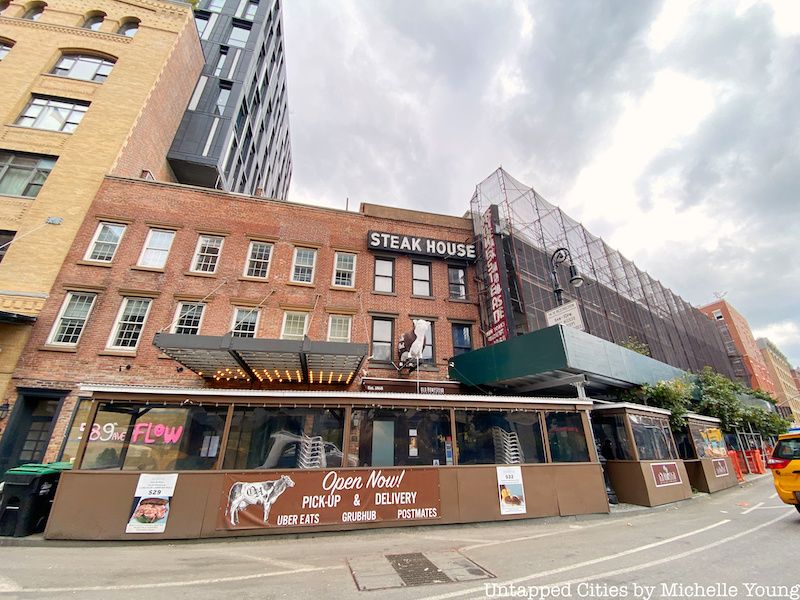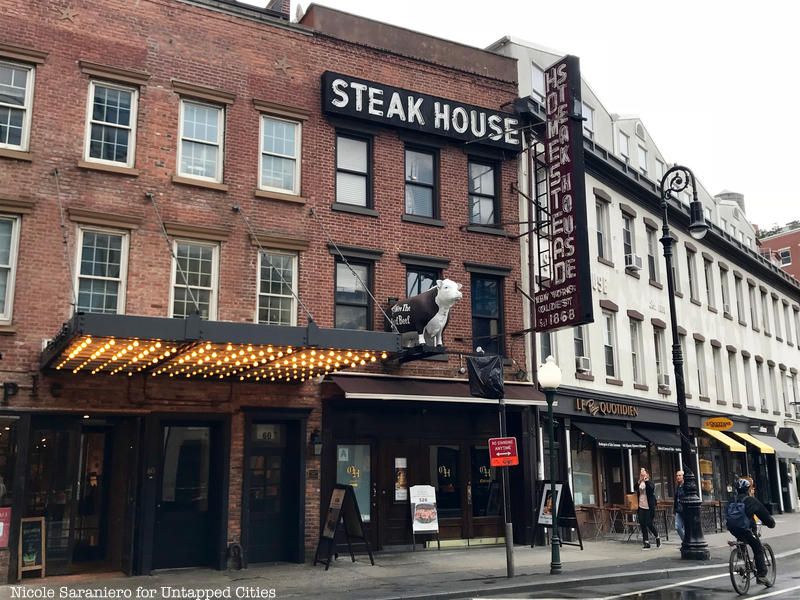Last-Minute NYC Holiday Gift Guide 🎁
We’ve created a holiday gift guide with presents for the intrepid New Yorker that should arrive just in time—


In a sad chapter of the story of New York City’s gentrification, sections of nine landmarked buildings, located at 44-54 Ninth Avenue and 351-55 West 14th Street, are being demolished, despite a battle between the Department of Buildings and the Greenwich Village Society For Historic Preservation. The row of homes, which are part of the Gansevoort Market Historic District, date back to the 1840s.
The announcement surrounding the demolition was sent out via an email, in which Village Preservation wrote that the “City has ordered the near-complete demolition of nine city, state, and federal landmarks on the northeast corner of 14th Street and 9th Avenue in the Gansevoort Market Historic District.”
The buildings, occupied by retail and dining tenants on the lower levels and by residential units on the upper levels, are some of the only surviving examples of pitched-roof row houses in Manhattan. Houses 44-54 were built between 1845 and 1846 by William Scott in the Greek Revival style and were originally part of “the Homestead Row.” In the storefronts were luncheonettes, cigar stores, and meat and produce shops. Adjacent to them is the Old Homestead Steakhouse, one of the oldest restaurants in New York City.
In an email to Untapped New York, Executive Director of Village Preservation Andrew Berman wrote, “It’s tragic to see these nine nearly two-century-old houses destroyed when this never had to happen. This reflects a callous disregard for our history and the purpose of our landmarks law by the city and this developer. We will now at best get a Disney-fied recreation of these buildings when the priority should have always been to preserve, maintain, and restore these historic landmarks. This should never have happened, and should never happen again.”

The homes are part of the Gansevoort Market Historic District, which occupies parts of 19 blocks within Greenwich Village and Chelsea. The District is composed of 140 contributing buildings, the High Line, and the historic street pattern of the neighborhood, as well as a lumber yard on W. 15th Street. Around the time of the area’s development, iron foundries, granite works, and lumber yards were major economic centers. Many tenements in the area were among the city’s first multi-family occupancies, attracting figures such as John Gottlieb Mathias Wendel, brother-in-law and business partner of John Jacob Astor I. Around 1880, the neighborhood began to rapidly change with the opening of two municipal markets: the open-air Farmers’ Market, which later became Gansevoort Market, and the West Washington Market.
The saga started in 2020, when real estate developer Tavros Holdings received permission to construct a tower behind and attached to the homes. This was met with some pushback from the Landmarks Preservation Commission, which reduced the size of the expected office tower, but those plans would change once construction actually began. BKSK Architects began construction on a shorter tower that removed one full floor from the original design, with a terra cotta facade featuring custom matte glazing, red and gray brick, and some gray metal paneling.
The Department of Buildings told Patch that an engineer reported that multiple buildings at the northeast corner intersection had “dangerous conditions” in which the front facade brick wall had partially separated, leading to the conclusion that the buildings were at risk of potential collapse. An emergency order was put out to destroy the facade but also preserve some of its elements while keeping the rest of the building. According to the DOB, the facade will be reconstructed using salvaged materials from the demolition.

In a letter to the mayor, Landmarks Preservation Commission, and the Department of Buildings, Andrew Berman wrote about the “extremely disturbing news” that the buildings would be part-demolished “on the basis of what has been determined to be unsafe conditions stemming from work approved by both agencies.” According to the letter, removing the facade could jeopardize the integrity of the rest of the building, which would not only destroy a landmarked building but also sidestep landmark requirements.
“This shocking and tragic development raises deeply troubling questions about the decision-making process and oversight which led to these circumstances, and the complete destruction — with the City’s approval — of nine houses built between 1842 and 1846 and recognized at the city, state, and federal level for their historic significance. These buildings, described In the designation report for the NYC Gansevoort Market Historic District as ‘a picturesque ensemble at the wide, angled intersection of West 14th and Hudson Streets and Ninth Avenue’ and ‘rare surviving examples of 1840s pitched-roofed rowhouses in Manhattan,’ have long stood as a symbol and anchor of the Gansevoort Market Historic District.”
He continued, “This tragic situation calls for a full accounting of all involved. We urge in the strongest of terms that if there is any safe way to preserve these nine buildings, it be done. If that is not possible, preservation of the historic materials and faithful reconstruction should be required. And the Landmarks Preservation Commission should end its anti-preservation practice of allowing demolition of all but the facades or parts of the shells of buildings.”
Next, check out 10 of NYC’s architectural holdouts!
Subscribe to our newsletter